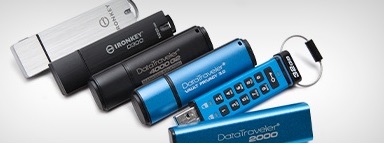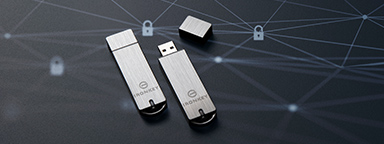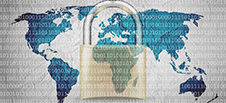Ask an Expert
Planning the right solution requires an understanding of your project’s security goals. Let Kingston’s experts guide you.
We notice you are currently visiting the UK site. Would you like to visit our main site instead?
Your web browser is out of date. Update your browser now for better experience on this site. https://browser-update.org/update-browser.html

Staying ahead with cybersecurity in 2022 is as great a priority as it has ever been. With new penalties in place for data breaches, security is critical to business survival. The challenges of the pandemic and resultant shift towards hybrid working have given security leaders much to consider as they adjust policies and protocols for this new environment.
To learn how to keep pace with increasingly advanced threats, we held a Twitter Q&A session hosted by one of our #KingstonCognate influencers, Prof. Sally Eaves. She was also joined by our community of experts, giving us some valuable insights and predictions for the coming year.
With the global switch to remote working and the rapid expansion of user devices for each network, came a threat landscape that vastly widened overnight. In addition, cyberthreat expansion and the associated risk has the potential to exploit newfound vulnerabilities along myriad new attack vectors:
Prof. Sally Eaves (@sallyeaves) also observes “Cybersecurity as a service is rising too - for example $250 Attackers are for Hire Per Job (& Up!) Denial of Service circa $311 per month. The list goes on - the growth of the cybercrime economy is significant.”
Along with increasing threats, attack frequency and sophistication are also on the rise. But why the change? “Ransomware, identity theft, social engineering and critical infrastructure failures are cybercrimes suitable for the digital era as human behaviour and interaction are increasingly influenced by technology” says Giuliano Liguori (@ingliguori).
Perhaps the most striking difference is that the company size is no longer important. In the good old days past, big fish such as enterprise networks were the target. Now everybody is a potential victim.
In Bill Mew’s (@BillMew) view “It is an ongoing cybersecurity arms race with both sides using AI and other advanced tech. As fast as the white hats use it to find and patch vulnerabilities, the black hats use it to find and exploit them”.

According to Prof. Sally Eaves, threat actors are changing tactics which is a major cause for concern. Take ransomware for example, “I predict that rather than holding a company's data hostage via encryption they may actually threaten to expose data and make customers choose between paying a ransom or facing regulatory fines. I think shifts like these are especially interesting – it is so true that expression, the only constant is change.”
CISOs are also faced with the challenge of measuring human risk. Unfortunately, risk management is less simple to quantify when it comes to the effects of awareness, training and culture spend vs physical equipment.
And with cybersecurity attacks against firmware outpacing investments to stop them, budget and resources for threat protection are additional areas of concern. “CISOs who know they genuinely lack resources to do the job properly would worry lots about what might be happening without them being aware. Others might worry about ‘social’ hacks of individuals that turn someone into a threat from within.” says Rafael Bloom (@RafiBloom73).
Ultimately, cyber resilience is underpinned by education, which will enable us to keep up with the pace of change. However, often the budget to adequately educate users is never anywhere near where it needs to be, or anywhere near as refined and role specific as the threats demand. In Ellie Hurst’s (@Advent_IM_Comms) experience “Tech always gets the lion's share, yet we know breach is so often caused by behaviour.”
According to Prof. Sally Eaves, getting the basics right is an essential move, requiring you to “audit where you are, improve visibility, reduce data noise and complexity, improve attack response resiliency. After all, 98% of attacks are negated via good cyber hygiene”.
Bill Mew adds that as well as good cyber hygiene, starting with the basics should encompass “1. Training and awareness - especially on phishing. 2. MFA (multi-factor authentication). 3. Cyber essentials like patching, anti-virus and firewalls.”
Sarah Janes (@SarahkJanes) reminds us that “more support is needed from central sources. It is not just about money but providing skilled people to facilitate the changes needed and work with businesses on a 1-1 basis.”
Regular updates and patches, together with password complexity guidelines and blocking unnecessary firewall ports, can all help strengthen security. In addition, Neil Cattermull (@NeilCattermull) believes that data mapping and monitoring plays a major role. He suggests that a regular delete of un-necessary stored data, data minimisation followed by access limitation, and a clear data retention policy can help businesses better protect their sensitive information. “Today, you must assume that every data touch point needs securing. The time you don’t is when you get hacked!”
No matter where you are on your entire cybersecurity journey, Kate Sukhanova (@ThisIsKateS) suggests every business should “make systems and products secure by design, rather than treating cybersecurity as an afterthought.” And since the digital ecosystem of SMEs is a growing target of cyber-attacks, “to create an ecosystem that is more resilient, collaboration and partnerships are essential” adds Giuliano Liguori.
Securing endpoints plays a very important role in cybersecurity health of any organisation. As a starting point, a focus on data loss prevention is critical, looking at the data that exists locally with your employees. Encrypted USBs can be very effective here, helping ensure that sensitive data can be stored and transferred securely.
Roland Broch (@rolandbroch) recommends that “all endpoint devices should ideally correspond to a defined security level and comply with the company's compliance requirements.” Since an endpoint can be any device that connects with IT from outside its firewall, every point is a potential point for attack - and therefore needs to be secured and managed. Elena Carstoiu (@elenacarstoiu) highlights that this is especially critical “in a business world that allows BYOD at work with the very same devices one uses with random Wi-Fi networks and in various usage scenarios.” Endpoint detection and response (EDR) is a growing field, with endpoint security solutions in great demand, likely driven by the expansion of traditional centrally managed enterprise networks. However, when the cyber ‘weakest link’ is the user operating the endpoints, how do you get the balance right when it comes to control? “Lock it down too much and it is a barrier to productivity, leave it too open and it is a hacker’s invitation!” says Nigel Tozer (@NigelTozer).
Kate Sukhanova thinks “encryption should be the default - but it must be combined with zero trust as it offers little defence against social engineering on its own.” New technology is also playing its part, with “operating systems like Android and iOS now building in an endpoint protection like biometric ID, password management, together with support for multi factor authentication” observes Rafael Bloom. Some endpoint protection platforms use sophisticated methods such as machine learning to automate investigations.
With all of this taken into account, is there a finish line? Perhaps not, according to Prof. Sally Eaves who thinks there is a heightened risk that may continue to grow. “Alongside endpoint choice, flexible working and apps everywhere means once traditional trust boundaries using perimeter security simply no longer exist.”
Endpoints are not “yours” anymore, with Bill Mew in agreement believing that “there is no silver bullet or absolute guarantee (even the NSA got hacked)”. He concludes that rather, a combination of risk awareness, cyber hygiene and intelligent use of tech and methodologies like zero trust, SASE and EDR solutions will be your best bet in protecting your ever-evolving endpoint security landscape.
At Kingston Technology, we consider ourselves trusted advisors in the encrypted USB space. We know that planning the right solution requires an understanding of security goals. Our Kingston Ask an Expert team can help you mitigate risk with our encrypted USB solutions. Kingston Is With You, no matter what you do, working to support your business needs. While 2022 may be full of unexpected challenges and opportunities for organisations, we are confident that our solutions can support businesses in any of their technology challenges.
#KingstonIsWithYou #KingstonIronKey
Was this helpful?

Planning the right solution requires an understanding of your project’s security goals. Let Kingston’s experts guide you.
No products match your current filter selection. Try adjusting your filters to explore more options.

Looking for improved data security & need to know what is encryption? Kingston covers the basics.

Hardware, not software-based password protection, is the best way to protect files and drives.

Secure important personal and private information on a PC with a hardware-encrypted SSD.

Breaches remain a major threat. Explore the need for comprehensive cybersecurity measures.

Here is a list of USB security features to consider for data protection.

Learn what the 3-2-1 data backup method is and why it is your best defence against ransomware.

Learn data security best practices with Dr. Vynckier, and the importance of offline backups.

David Clarke covers encryption, super user safeguards, vulnerability management, and training.

Learn how Kingston IronKey's solutions helped EgoMind enhance their data security hygiene.

Built for disparate purposes, client SSDs and enterprise SSDs have different properties.

We discuss NIS2 and DORA, and how organisations can turn compliance into an opportunity.

We discuss the shifts in how organisations are storing and encrypting sensitive data.

Kingston examines how to secure sensitive files with the increasing vulnerability of email.

Learn how Kingston IronKey hardware-encrypted solutions supports NIS2 Directive compliance.

Kingston IronKey has hardware options to protect small and medium businesses against cybercrime.

FIPS 140-3 Level 3 is certified by the world-leading agency NIST as the apex of encryption.

Questions to ask when seeking the right SSD for your organisation’s data center.

Our infographic showcases the differences between software and hardware-based encryption.

2023 has been a year full of challenges and innovations. But what will 2024 bring?

Learn about two methods that give SMBs superior resilience vs ransomware: encryption and backups.

In this whitepaper, we explain how to enforce a DLP strategy, while allowing USB drive use.

Enterprise-grade and military-grade digital security: two high standards with different requirements.

Learn how hardware encryption can protect a travelling lawyer’s confidentiality with secure file storage.

How is pen testing ensuring Kingston IronKey USB drives lead the way in trusted data security?

Hardware encrypted Kingston IronKey drives protects organisations’ data on the move.

Bring your own device (BYOD) policy is tricky for employers. How to balance security & convenience?

How do encrypted drives improve cybersecurity and compliance for finance companies? Kingston explains.

DLP offers tools for network admins to protect sensitive data from cybercrime and negligence.

A look at how the requirement for data encryption can be key to any organisation's security strategy.

How can we bolster network security with remote working and international travel so common now?

Invest in encrypted drives so you do not incur expensive legal fees if they are lost or stolen.

Discover why national security agencies trust Kingston IronKey to protect their data.

A company’s IT specialists should be expected to add data security to the PCs of remote workers.

Kingston’s three key practices for robust DLP for businesses that handle sensitive data.

You can read and write to an encrypted USB flash drive with an iPad or iPhone with the right adaptor. Here’s how.

Learn why hardware encryption beats software encryption for law firm data protection.

A brief explaining the purpose and types of data security software available.

Passphrases are superior to complex passwords for keeping data secure, with many powerful benefits.

HIPAA requires healthcare organisations to keep patient data safe at all times, including in transit.

This requires encryption of sensitive data, appointing a Security Officer, cyber security programmes and policy adoption.

Kingston IronKey encrypted USBs are a security consideration for organisations of all sizes.

We compare unencrypted and encrypted USB drives and explain how to keep data secure!

Learn how Kingston IronKey is protecting the intellectual property with customisation.

Discover why Kingston IronKey is the go-to solution for protecting financial services data.

Learn how Kingston IronKey is securing the military operations’ data.

How can you get your organisation to use encrypted drives and make them part of your security policy? Here are some tips.

Learn how Kingston IronKey is protecting telecoms industry's data using encryption.

Encryption is an incredibly helpful option for creatives to protect their clients’ important files.

Kingston IronKey encrypted USBs: a small but important part of any organisation’s security strategy.

Kingston IronKey can help mitigate data loss due to the rise in lost electronic devices.

In this eBook, we explore how Encrypted USB drives have become a key tool in keeping data secure.

How to use your IronKey Vault Privacy 80 External SSD: set password, connecting to a PC and more.

Organisations are considering data security options to protect against private mobile data breaches.

Discover how Kingston IronKey is protecting the sensitive data of the finance sector.

Here is how Kingston IronKey helped protect the sensitive data of the Energy industry.

Protecting data on the move with superior hardware-based Advanced Encryption Standard (AES) 256.

Users can disable software-based encryption, which can lead to legal fees if the drive is lost.

We explore Tomasz Surdyk's thoughts on how all entities can stay secure in the digitised world.

Don’t plug any USB drives into your computer if you don’t know exactly where they came from.

What we learned from Kingston’s experts and tech influencers on work-from-home enablement Twitter chat.

There are benefits to using both cloud storage and hardware-based encryption.

We explore the top 12 tips small and medium size enterprises can take to enhance cybersecurity.

We’ve examined several factors using unique research to identify what may impact markets globally in 2022.

2021 has been a year full of challenges and innovations. But what will 2022 bring?

Prof Sally Eaves shares her thoughts on the SME cybersecurity landscape and the need for education & support.

Bill Mew shares his thoughts how the largest security challenges need commitment from the boardroom.

Rob May shares his thoughts on how close we are to edge computing and the security it requires.

The pandemic has increased internet traffic, which has placed importance on the role of data centers.

The use of DLP software, VPNs, Encrypted SSDs and USBs, will help mitigate some risks of remote working.

Cameron Crandall of Kingston helps you decide if you should move to your server storage to NVMe SSDs.

There are many advantages to using a dedicated hardware encryption processor in USB flash drives.

What will 2021 bring in Tech and trends? What do our KingstonCognate members and industry experts predicting for the future?

Cyber security and data privacy are everyone’s responsibility. What are the key considerations?

Learn why the future of business depends on SSD-enabled SDS, and how SSD fits into a Software Defined Storage Solutions.

Kingston & Matrix42 partnered to give optimal endpoint security solution in multiple sectors to mitigate risks.

The importance of organisations to consider Revenue, Profit & Risk as equal in organisations to ensure they mitigate data security & cyber security risks. Read this article from Industry Expert, Bill Mew & he will provide you with an insight on this topic.

What do industry experts think has changed since the introduction of GDPR?

Data centres should be using server SSDs. There are many benefits over client drives and costs have come down.

NVMe is now the standard protocol for SSDs to empower data centres and enterprise environments.

Cloud and on-premise data centre managers can learn a lot from supercomputing.

Find out how Hardwareluxx were able to manage the growth of their web traffic using Kingston's DC500M SSD.

SDS hasn’t lived up to its hype but now that NVMe is more affordable, the commodity hardware is ready to deliver.

Choosing the right SSD for your server is important since server SSDs are optimized to perform at a predictable latency level while client (desktop/laptop) SSDs are not. These difference result in better uptime and less lag for critical apps and services.

To work from home you need a good workspace for your PC, the right conferencing gear, and a secure connection.

What strategies can organisations use to best secure customers data in a post-GDPR world with the ever-evolving nature of cyber security threats? Kingston pooled the knowledge of some of the UK’s most experienced commentators in cyber security to discuss how data protection has changed since the introduction of GDPR.

This whitepaper demonstrates how using Kingston Technology’s Data Centre DC500 SSDs can reduce your overall capital and licence costs by 39%.

You already know that remote working is a business enabler. But the challenges posed to your network security and compliance with GDPR are too big to ignore.

How to enable and disable Microsoft’s BitLocker eDrive feature to leverage hardware encryption on your Kingston SSD.

Some of Kingston and IronKey's Secure USB Flash drives are powered by partners, licensed technology, or services.

256-bit AES hardware-based XTS block cipher mode encryption is used in DT 4000G2 and DTVP 3.0.

Firmware/hardware PFAIL protection is an highly effective method for preventing data loss in enterprise SSD.

Kingston datacenter SSDs provide excellent resiliency to protect sensitive data in OLTP workloads.

HPC can require massive amounts of data. SSDs consume a fraction of the power of their spinning disk.

End-to-End Data Protection protects customer’s data as soon as it is transferred by the host system to the SSD, and then from the SSD to the host computer. All Kingston SSDs incorporate this protection.

This program offers the options most frequently requested by customers, including serial numbering, dual password and custom logos. With a minimum order of 50 pieces, the programme delivers precisely what your organisation needs.

Everyday working life has changed radically and so have traditional ways of working: thanks to mobile storage media, we can access our data practically at any time from any location, and can work on our data wherever we are.

Most IronKey and Kingston secure USB flash drives are FIPS 140-2 Certified.

Heathrow Airport in London (30 October 2017) uses unencrypted USB drives for its non-cloud storage. Unfortunately, it was not standardized on encrypted USB drives.

Storage can be the most challenging component for VDI performance.

Testing is a cornerstone of our commitment to deliver the most reliable products on the market. We perform rigorous tests on all of our products during each stage of production. These tests ensure quality control throughout the entire manufacturing process.



